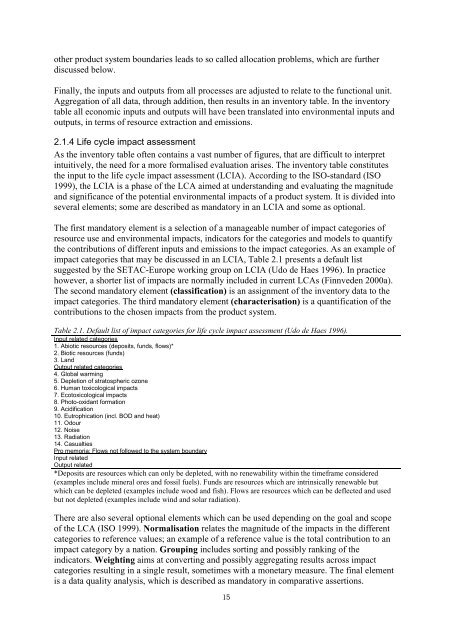Life Cycle Assessments of Energy From Solid Waste (PDF)
Life Cycle Assessments of Energy From Solid Waste (PDF)
Life Cycle Assessments of Energy From Solid Waste (PDF)
You also want an ePaper? Increase the reach of your titles
YUMPU automatically turns print PDFs into web optimized ePapers that Google loves.
other product system boundaries leads to so called allocation problems, which are further<br />
discussed below.<br />
Finally, the inputs and outputs from all processes are adjusted to relate to the functional unit.<br />
Aggregation <strong>of</strong> all data, through addition, then results in an inventory table. In the inventory<br />
table all economic inputs and outputs will have been translated into environmental inputs and<br />
outputs, in terms <strong>of</strong> resource extraction and emissions.<br />
2.1.4 <strong>Life</strong> cycle impact assessment<br />
As the inventory table <strong>of</strong>ten contains a vast number <strong>of</strong> figures, that are difficult to interpret<br />
intuitively, the need for a more formalised evaluation arises. The inventory table constitutes<br />
the input to the life cycle impact assessment (LCIA). According to the ISO-standard (ISO<br />
1999), the LCIA is a phase <strong>of</strong> the LCA aimed at understanding and evaluating the magnitude<br />
and significance <strong>of</strong> the potential environmental impacts <strong>of</strong> a product system. It is divided into<br />
several elements; some are described as mandatory in an LCIA and some as optional.<br />
The first mandatory element is a selection <strong>of</strong> a manageable number <strong>of</strong> impact categories <strong>of</strong><br />
resource use and environmental impacts, indicators for the categories and models to quantify<br />
the contributions <strong>of</strong> different inputs and emissions to the impact categories. As an example <strong>of</strong><br />
impact categories that may be discussed in an LCIA, Table 2.1 presents a default list<br />
suggested by the SETAC-Europe working group on LCIA (Udo de Haes 1996). In practice<br />
however, a shorter list <strong>of</strong> impacts are normally included in current LCAs (Finnveden 2000a).<br />
The second mandatory element (classification) is an assignment <strong>of</strong> the inventory data to the<br />
impact categories. The third mandatory element (characterisation) is a quantification <strong>of</strong> the<br />
contributions to the chosen impacts from the product system.<br />
Table 2.1. Default list <strong>of</strong> impact categories for life cycle impact assessment (Udo de Haes 1996).<br />
Input related categories<br />
1. Abiotic resources (deposits, funds, flows)*<br />
2. Biotic resources (funds)<br />
3. Land<br />
Output related categories<br />
4. Global warming<br />
5. Depletion <strong>of</strong> stratospheric ozone<br />
6. Human toxicological impacts<br />
7. Ecotoxicological impacts<br />
8. Photo-oxidant formation<br />
9. Acidification<br />
10. Eutrophication (incl. BOD and heat)<br />
11. Odour<br />
12. Noise<br />
13. Radiation<br />
14. Casualties<br />
Pro memoria: Flows not followed to the system boundary<br />
Input related<br />
Output related<br />
*Deposits are resources which can only be depleted, with no renewability within the timeframe considered<br />
(examples include mineral ores and fossil fuels). Funds are resources which are intrinsically renewable but<br />
which can be depleted (examples include wood and fish). Flows are resources which can be deflected and used<br />
but not depleted (examples include wind and solar radiation).<br />
There are also several optional elements which can be used depending on the goal and scope<br />
<strong>of</strong> the LCA (ISO 1999). Normalisation relates the magnitude <strong>of</strong> the impacts in the different<br />
categories to reference values; an example <strong>of</strong> a reference value is the total contribution to an<br />
impact category by a nation. Grouping includes sorting and possibly ranking <strong>of</strong> the<br />
indicators. Weighting aims at converting and possibly aggregating results across impact<br />
categories resulting in a single result, sometimes with a monetary measure. The final element<br />
is a data quality analysis, which is described as mandatory in comparative assertions.<br />
15
















